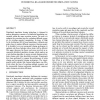9 search results - page 1 / 2 » HLA-Based Distributed Simulation Cloning |
DSRT
2004
IEEE
13 years 8 months ago
2004
IEEE
Distributed simulation cloning technology is designed to analyze alternative scenarios of a distributed simulation concurrently within the same execution session. The goal is to o...
ADHOCNETS
2009
Springer
13 years 11 months ago
2009
Springer
Abstract. Wireless sensor networks are vulnerable to the node clone attack because of low-cost, resource-constrained sensor nodes, and uncontrolled environments where they are left...
JSAC
2010
12 years 11 months ago
2010
Abstract--Wireless sensor networks (WSNs) deployed in hostile environments are vulnerable to clone attacks. In such attack, an adversary compromises a few nodes, replicates them, a...
PVLDB
2010
13 years 2 months ago
2010
Enterprises often need to assess and manage the risk arising from uncertainty in their data. Such uncertainty is typically modeled as a probability distribution over the uncertain...
ICNP
2009
IEEE
13 years 2 months ago
2009
IEEE
Sensor networks deployed in hostile areas are subject to node replication attacks, in which an adversary compromises a few sensors, extracts the security keys, and clones them in a...

